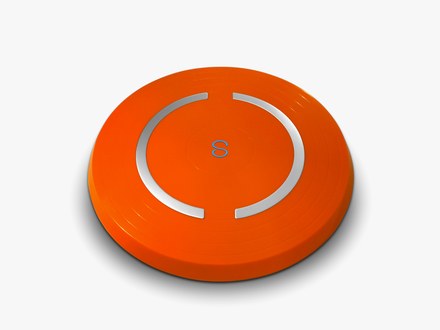The scale of the future does not have numbers or dials. It does not tweet out your body fat percentage, nor does it calculate how much water you’re currently retaining. The scale of the future will not scream at you when you’ve come home after a long night of drinking and ordered an entire pizza, fully loaded, to eat by yourself. It knows when you’ve done this, of course. It just doesn’t tell you.
The scale of the future won’t even tell you how much you weigh. It doesn’t have a screen to display your weight because, if you ask behavioral economist Dan Ariely, weight is a metric of the past. Ariely has spent his career researching the invisible machinery of human choice: why we neglect to save money for things we know we need, why we lie to our friends, and to ourselves. Recently, he’s turned his focus toward the choices we make about our health. Why, Ariely wondered, do people have such a hard time making healthy choices?
The Shapa is a new kind of bathroom scale with no screen.
That’s where the scale comes in. Ariely imagines the common bathroom gadget as a gateway to better understanding our health, a way to subtly reshape human health behavior one pound at a time. But in order to do that, Ariely wants to rethink the scale’s design. And so he has with Shapa. Since it lacks the familiar screen, it doesn’t even look like a scale. Most scales remind people of the shame, regret, and self-disgust they feel when they step onto one. This one is designed to remind people of health, and of their choices. More encouragement, less data. Ariely’s dream of the unquantified self.
Scale Up
When Ariely set out to understand how people were monitoring their health, he found almost no limit to what one can track. A consumer can choose from hundreds of bracelets and watches that record the number of steps walked, flights of stairs climbed, calories burned, breaths taken, or hours slept. There are gadgets to analyze body tissue, measure body fat, muscle mass, water percentage, or bone density. The promise of these devices amounts to more than just continuous monitoring of a particular health marker. Each brings one more data point in a broader ecosystem of health tech. It’s telling that companies like Fitbit and Garmin make smart scales designed to work specifically with their own wearables, creating all-in-one tracking systems.
The problem, Ariely says, is that the actual story of our health gets lost in these granular data points. That’s especially true of weight, which can fluctuate as much as three pounds throughout the day. Watching the scale undulate—to a tenth of a pound!—tells us nothing at all about our overall well-being. “By giving people more granularity,” he says, “we’re making information less useful.”
“With the quantified self, we almost never celebrate that nothing is happening.” — Dan Ariely
Even the simplest nugget of data can be misleading. When you see your weight go up two pounds, you assume you’ve done something wrong. When you see your weight go down two pounds, you assume you’ve done something right. Most of the time, you haven’t done anything at all.
While weight can be a proxy for health, it’s not an especially good one. If you step on the scale and weigh 10 pounds less, the number on the screen doesn’t tell you if you’ve lost 10 pounds of fat or 10 pounds of muscle—or if, by chance, someone has chopped off your arm and you’ve simply lost 10 pounds of limb.
“It’s incredibly confusing and demotivating,” says Ariely. “So we said, ‘OK, let’s rethink the scale.'”
The Shapa scale is still very much a “smart scale.” It captures bone density and muscle mass in addition to overall weight, and it connects to your phone. But it never tells you how much you weigh, not even in the app. Instead, it analyzes all the granular information about your body and translates it into simple humanspeak: either you’re doing fine, or you’re not. If you ask Ariely, that’s all you really need to know.
Weighing In
The Shapa scale looks like a round saucer the size of a small pizza. It comes in black, oak, or cherry wood, with a thin silver ring encircling the small “S” logo in the center. Standing on it feels less like a daily weigh in, and more like one is about to be beamed down to an exoplanet. If you step on without socks and shoes, the device sends a small electrical current through your body to capture bone and muscle density along with overall weight. But the scale itself reveals none of this at that moment. You simply step on, and step off.
Everything else happens in the Shapa app, which connects to the scale via Bluetooth. The app also pulls data from the health kit on your phone—so, if you wear an Apple Watch or a Fitbit, or track your workouts through a mobile app like Runkeeper, Shapa can synthesize that data along with your weight. Then, it then presents your health on a five-point scale: Either you’re a little better, a little worse, much better, much worse, or basically the same. It’s this last result that excites Ariely. “With the quantified self, we almost never celebrate that nothing is happening,” he says.
Shapa’s five-point system takes into account the way people actually gain and lose weight. A few pounds up or down means nothing at all, especially if it’s not sustained over time. So the app creates a running average of weigh-ins over the past three weeks, and uses that to give feedback rather than your weight in a given moment. “If you’re within one standard deviation,” Ariely says, “then we say, ‘You’re just the same.'” He thinks this approach will help people better understand how their choices are affecting their health overall, rather than what makes someone gain or lose a few fractions of a pound in a day.
The Shapa scale costs $129, and requires a year-long subscription to the app at $10 per month. (From now until February, early adopters can get the scale for $99 with a $7.95 monthly fee.) The price tag is enough to scare some people off, but Ariely thinks even that comes with a behavioral benefit: If you’re paying for this thing every month, you’re more likely to step on it every day. And if you step on it every day, you’re more likely to consider your health choices.









